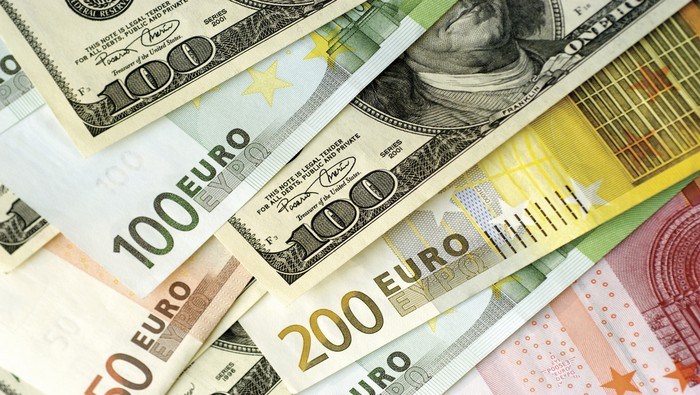The Fed will maintain the “higher for longer” interest rates argument.
The easing of tensions in the Middle East has improved the demand for risky assets.
Gold price (XAU/USD) faces pressure above the crucial support of $2,300 in Thursday’s early New York session. The US Dollar strengthened after the United States Bureau of Economic Analysis (BEA) reported a significant rise in the Q1 Gross Domestic Product (GDP) Price Index to 3.1% from the former reading of 1.7%. This has deepened the risks of the Federal Reserve (Fed) delaying rate cuts later this year. The US Dollar Index (DXY), which tracks the US Dollar’s value against six major currencies, recaptures 106.00. A significant rise in the US Dollar makes Gold an expensive investment for currency holders.
While a stubbornly higher price index has deepened fears of interest rates remaining higher, a sharp decline in GDP growth has raised concerns over the US economic outlook. The US economy expanded at a significantly slower pace of 1.6% from expectations of 2.5%. In the last quarter of 2023, the economy grew strongly by 3.4%.
A significant fall in the GDP growth rate is unlikely to scrap the speculation for the Fed to achieve the so-called soft landing, in which the central bank achieves price stability without triggering a recession. However, this indicates that the economy struggles to bear the consequences of higher interest rates by the Fed and is expected to dampen investors’ confidence in the strong economic outlook.
Going forward, investors will focus on the core Personal Consumption Expenditure Price Index (PCE) data for March, which will guide the next move in the Gold price. A significant change in the above-mentioned economic indicator will likely force traders to reassess expectations for the timing of Fed rate cuts. Currently, financial markets anticipate the first cut in September.
Gold price faces selling pressure above $2,300 as the US Dollar rises sharply. The US Dollar advances amid hopes that the Fed will maintain its current interest rate framework for a longer period.
The week is full of volatile events as the core PCE inflation data will follow the Q1 GDP data – the Fed’s preferred inflation measure – for March, which will be published on Friday. Core PCE inflation is expected to have grown steadily by 0.3% on a month-on-month basis, with annual figures softening to 2.6% from the 2.8% recorded in February.
The underlying inflation data will significantly influence the Fed’s interest rate outlook ahead of its next meeting on May 1. In the May policy meeting, the Fed is widely anticipated to keep interest rates unchanged in the range of 5.25%-5.50%.
The near-term outlook for Gold remains uncertain as safe-haven demand has weakened due to waning fears of widening Middle East conflict. Also, Fed policymakers see no urgency for rate cuts due to higher inflationary pressures and tight labor market conditions
Gold price seems vulnerable above the round-level support of $2,300 ahead of crucial US data. The 20-day Exponential Moving Average (EMA) at $2,314 provides support to the precious metal, suggesting that the near-term outlook has turned volatile.
On the downside, a three-week low near $2,265 and March 21 high at $2,223 will be major support zones for the Gold price.
The 14-period Relative Strength Index (RSI) falls below 60.00, suggesting that a bullish momentum is weakening. However, the upside bias is intact until the RSI sustains above 40.00.
A country’s Gross Domestic Product (GDP) measures the rate of growth of its economy over a given period of time, usually a quarter. The most reliable figures are those that compare GDP to the previous quarter e.g Q2 of 2023 vs Q1 of 2023, or to the same period in the previous year, e.g Q2 of 2023 vs Q2 of 2022. Annualized quarterly GDP figures extrapolate the growth rate of the quarter as if it were constant for the rest of the year. These can be misleading, however, if temporary shocks impact growth in one quarter but are unlikely to last all year – such as happened in the first quarter of 2020 at the outbreak of the covid pandemic, when growth plummeted.
A higher GDP result is generally positive for a nation’s currency as it reflects a growing economy, which is more likely to produce goods and services that can be exported, as well as attracting higher foreign investment. By the same token, when GDP falls it is usually negative for the currency. When an economy grows people tend to spend more, which leads to inflation. The country’s central bank then has to put up interest rates to combat the inflation with the side effect of attracting more capital inflows from global investors, thus helping the local currency appreciate.
When an economy grows and GDP is rising, people tend to spend more which leads to inflation. The country’s central bank then has to put up interest rates to combat the inflation. Higher interest rates are negative for Gold because they increase the opportunity-cost of holding Gold versus placing the money in a cash deposit account. Therefore, a higher GDP growth rate is usually a bearish factor for Gold price.
Share:
Feed news
Information on these pages contains forward-looking statements that involve risks and uncertainties. Markets and instruments profiled on this page are for informational purposes only and should not in any way come across as a recommendation to buy or sell in these assets. You should do your own thorough research before making any investment decisions. FXStreet does not in any way guarantee that this information is free from mistakes, errors, or material misstatements. It also does not guarantee that this information is of a timely nature. Investing in Open Markets involves a great deal of risk, including the loss of all or a portion of your investment, as well as emotional distress. All risks, losses and costs associated with investing, including total loss of principal, are your responsibility. The views and opinions expressed in this article are those of the authors and do not necessarily reflect the official policy or position of FXStreet nor its advertisers. The author will not be held responsible for information that is found at the end of links posted on this page.
If not otherwise explicitly mentioned in the body of the article, at the time of writing, the author has no position in any stock mentioned in this article and no business relationship with any company mentioned. The author has not received compensation for writing this article, other than from FXStreet.
FXStreet and the author do not provide personalized recommendations. The author makes no representations as to the accuracy, completeness, or suitability of this information. FXStreet and the author will not be liable for any errors, omissions or any losses, injuries or damages arising from this information and its display or use. Errors and omissions excepted.
The author and FXStreet are not registered investment advisors and nothing in this article is intended to be investment advice.





